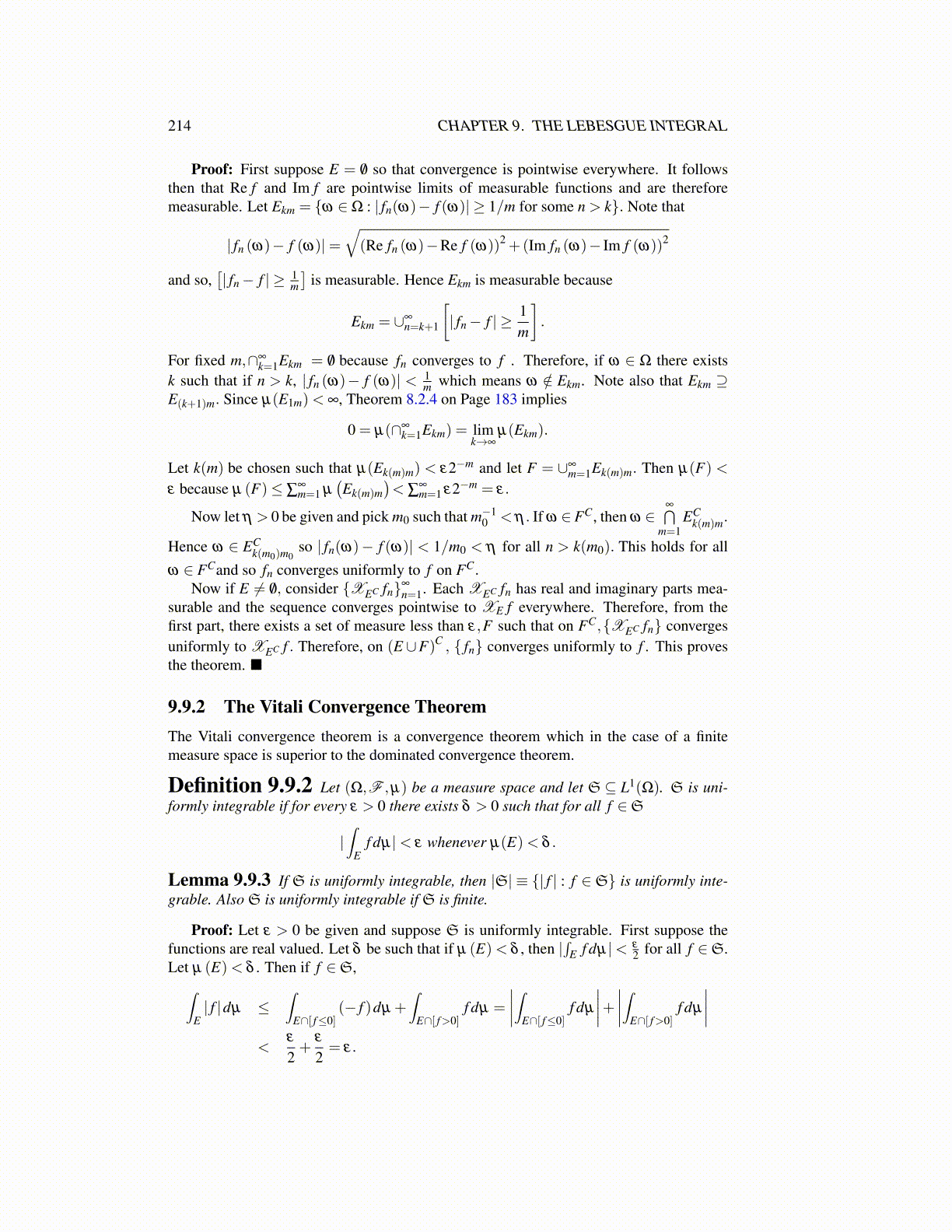
214 CHAPTER 9. THE LEBESGUE INTEGRAL
Proof: First suppose E = /0 so that convergence is pointwise everywhere. It followsthen that Re f and Im f are pointwise limits of measurable functions and are thereforemeasurable. Let Ekm = {ω ∈Ω : | fn(ω)− f (ω)| ≥ 1/m for some n > k}. Note that
| fn (ω)− f (ω)|=√
(Re fn (ω)−Re f (ω))2 +(Im fn (ω)− Im f (ω))2
and so,[| fn− f | ≥ 1
m
]is measurable. Hence Ekm is measurable because
Ekm = ∪∞n=k+1
[| fn− f | ≥ 1
m
].
For fixed m,∩∞k=1Ekm = /0 because fn converges to f . Therefore, if ω ∈ Ω there exists
k such that if n > k, | fn (ω)− f (ω)| < 1m which means ω /∈ Ekm. Note also that Ekm ⊇
E(k+1)m. Since µ(E1m)< ∞, Theorem 8.2.4 on Page 183 implies
0 = µ(∩∞k=1Ekm) = lim
k→∞µ(Ekm).
Let k(m) be chosen such that µ(Ek(m)m) < ε2−m and let F = ∪∞m=1Ek(m)m. Then µ(F) <
ε because µ (F)≤ ∑∞m=1 µ
(Ek(m)m
)< ∑
∞m=1 ε2−m = ε.
Now let η > 0 be given and pick m0 such that m−10 < η . If ω ∈FC, then ω ∈
∞⋂m=1
ECk(m)m.
Hence ω ∈ ECk(m0)m0
so | fn(ω)− f (ω)| < 1/m0 < η for all n > k(m0). This holds for all
ω ∈ FCand so fn converges uniformly to f on FC.Now if E ̸= /0, consider {XEC fn}∞
n=1. Each XEC fn has real and imaginary parts mea-surable and the sequence converges pointwise to XE f everywhere. Therefore, from thefirst part, there exists a set of measure less than ε,F such that on FC,{XEC fn} convergesuniformly to XEC f . Therefore, on (E ∪F)C , { fn} converges uniformly to f . This provesthe theorem. ■
9.9.2 The Vitali Convergence TheoremThe Vitali convergence theorem is a convergence theorem which in the case of a finitemeasure space is superior to the dominated convergence theorem.
Definition 9.9.2 Let (Ω,F ,µ) be a measure space and let S ⊆ L1(Ω). S is uni-formly integrable if for every ε > 0 there exists δ > 0 such that for all f ∈S
|∫
Ef dµ|< ε whenever µ(E)< δ .
Lemma 9.9.3 If S is uniformly integrable, then |S| ≡ {| f | : f ∈S} is uniformly inte-grable. Also S is uniformly integrable if S is finite.
Proof: Let ε > 0 be given and suppose S is uniformly integrable. First suppose thefunctions are real valued. Let δ be such that if µ (E)< δ , then |
∫E f dµ|< ε
2 for all f ∈S.Let µ (E)< δ . Then if f ∈S,∫
E| f |dµ ≤
∫E∩[ f≤0]
(− f )dµ +∫
E∩[ f>0]f dµ =
∣∣∣∣∫E∩[ f≤0]f dµ
∣∣∣∣+ ∣∣∣∣∫E∩[ f>0]f dµ
∣∣∣∣<
ε
2+
ε
2= ε.